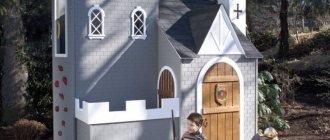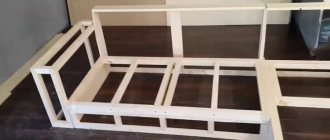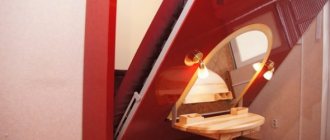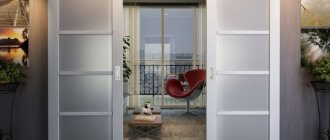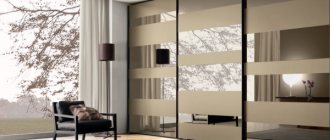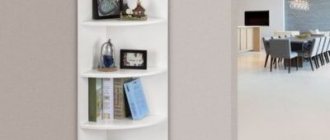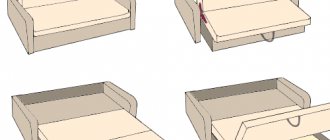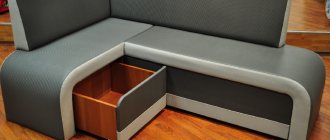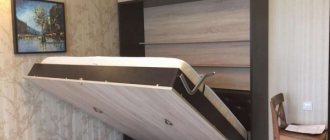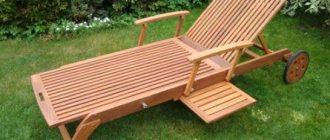Corner furniture will help you properly arrange a recreation area in a small living space. It fits perfectly into the geometry of the room, retains maximum usable area, providing enough space for guests. You can save money on buying furniture of a similar configuration if you assemble a corner sofa with your own hands, showing not only the skills of working with various materials, but also the abilities of a designer. The main thing is to be extremely careful in your work, not to rush, and the result will delight you with beauty and durability.
Benefits of DIY
Assembling a corner sofa with your own hands, if you have the appropriate tools and materials, will not cause difficulties even for novice craftsmen. Such upholstered furniture will help zone the space of the room. Equipped with spacious drawers, corner sofas can accommodate many household items.
When wondering whether it’s worth spending time searching for the right model in the store or whether it’s easier to build a sofa with your own hands, we pay attention to the following points:
- furniture assembled by hand always fits into the interior of the room and is ideal in size;
- the choice of upholstery colors does not depend on the assortment provided by the manufacturer;
- by making a soft corner yourself, you can minimize costs;
- When assembling a kitchen corner sofa with your own hands, you can personally control the quality of the product so as not to have doubts about its strength and durability.
The main advantage of assembling a soft corner sofa with your own hands is aesthetic pleasure, a feeling of pride from the work done. During the production process, you can feel like a real designer and acquire useful skills. Positive emotions will be enhanced by enthusiastic reviews from others.
Quality assurance
Cast aside all doubts before purchasing, because you are protected by a guarantee from the online publisher.
The publishing house (SM) has been operating on the Internet since 2006 and is responsible for quality assurance. If the video course does not help you make a corner sofa with your own hands, then you can return it within 6 months.
We founded the Furniture Makers Forum (), which has more than 181,000 registered users. If there were dissatisfied people, you would know it!
The sponsors of our competitions and information partners are well-known companies in the furniture business such as MDM-Komplekt, KAMI, CMT, Stavros and others.
Materials and tools
A detailed diagram of the design of a corner sofa will help you save time and money. It is also recommended to make a list of necessary materials and tools in advance. In the process of creating furniture you may need:
- timber from coniferous trees (used for the frame);
- plywood (preferably birch) is needed for covering the base;
- Fiberboard is useful at the stage of installing the bottom and assembling storage boxes;
- laminated chipboard is most often used to make armrests;
- soft materials (foam rubber or padding polyester) are indispensable when stuffing the back of a sofa or pillows;
- upholstery fabrics (thick fabrics impregnated with special water-repellent compounds that protect against excessive contamination);
- fasteners (corners, screws, nails);
- retractable mechanisms for drawers;
- furniture legs (it is more convenient to use elements on wheels);
- consumables (threads, glue).
One of the important aspects of making a corner sofa with your own hands is the correct selection of the necessary tools:
- saw - for cutting large wooden elements;
- a screwdriver, without which it is very difficult to quickly assemble any structure;
- sewing machine (preferably electric) – for sewing covers;
- a furniture stapler that allows you to firmly fix the fabric in the right places.
Depending on the complexity of the design, the minimum list of necessary devices may be expanded during the work process.
timber
Plywood
Chipboard
Fiberboard
Furniture fittings
Foam rubber
Upholstery fabrics
Drawing
In order to avoid problems when cutting and assembling parts during the manufacturing of a corner sofa, it is necessary to make a preliminary drawing of the future product. It will need to indicate the dimensions of all individual elements, methods of attaching them to each other and materials of manufacture. You can make a drawing in different ways:
- Draw your own version of the furniture on a piece of paper. In this case, you need to be able to calculate dimensions and draw in different projections.
- Find the best option on the Internet and modify it in your own way. This is the easiest way when you can choose an original design with all sizes and mounting methods.
- Use a special program on your computer. In this case, you need to be able to work with the cutting program. As a result, you will get a diagram in all variations and with the designation of all elements.
It is necessary to indicate on the drawing:
- the dimensions of the sofa and the overall dimensions of all components;
- back angle;
- when manufacturing a folding model, it is necessary to specify the transformation mechanism;
- thickness and hardness of upholstery.
Attention: when creating a drawing, it is necessary to take into account the projections of all working units of the furniture item. Therefore, you cannot do without the ability to work with computer programs or the basics of drawing.
Drawings and diagrams
Competently compiled drawings and diagrams for assembling a corner sofa with your own hands determine the quality of the final result. Sketches should be extremely simple and understandable. The basic principle is to describe the size and location of all parts of future furniture. After the drawing of the future soft corner has been drawn, a detailed diagram of the location of all fasteners, reinforcing parts, partitions, and, if necessary, drawers is drawn up.
Some expert recommendations will help you do everything correctly:
- When choosing the dimensions of furniture, it is important to measure in advance the place where it will be installed;
- first of all, a sketch is drawn, which necessarily indicates the length of the two halves of the sofa, its depth and the height of the back (this parameter can be arbitrary);
- The width of the sofa frame is calculated as the difference between the total length of the two halves and the depth.
The main points that are taken into account when creating a drawing of a sofa:
- back angle;
- dimensions of the entire structure and its individual parts;
- the need to install folding mechanisms;
- the need to arrange storage compartments;
- height of sofa legs.
A secret from a professional: for ease of reading drawings and diagrams, when creating them, you must use different colors for each material.
For example, a timber base is shaded yellow, chipboard surfaces are shaded gray, and foam upholstery areas are shaded pink. The direction for tightening the screws is drawn with red arrows. This will help you quickly navigate and significantly reduce time costs.
What is a dolphin?
The dolphin-like mechanism gets its name from the fact that the unfolding process is similar to the diving of this marine mammal.
Dolphin refers to removable mechanisms. In this design, the second half of the “mattress” is located under the seat. And when it needs to be opened, the drawer moves forward, the lower part rises to the level of the upper one.
Step-by-step manufacturing instructions
Let's consider step by step how to make a corner sofa with your own hands. In accordance with the previously drawn diagram, the parts must be numbered and laid out as they are introduced into the work. The smallest elements must be set aside separately from large parts. You can cut timber, fiberboard and chipboard panels yourself, but it is much easier and faster to order the work from professionals. Assembly begins with large parts, gradually building up small elements onto the base.
All components are connected to each other with screws. To enhance strength, each part is first glued, and only then the two parts are pulled together.
Creating a wireframe
Assembling a sofa begins with creating a frame made of timber. Two long and two short blanks are connected into a rectangle. After the beam is fastened with self-tapping screws, metal corners are attached to the corners. Additional transverse supports are fixed in the center of the backrest. This ensures the strength of the sofa base.
The bottom of the corner sofa box is sewn up with a fiberboard sheet of the appropriate size. To fix the material, use special small furniture nails or a stapler with staples (which is much easier and faster). The second half and the corner insert are made using the same principle. After all three parts of the corner sofa base are assembled, they are fastened together with bolts and nuts.
A washer placed in front of the nut will help protect the wood from damage by metal fasteners.
Next, we begin to create the back frame. To do this, you will need six bars, identical in size, cut at an angle relative to the level of the seat. The frame of the structural element is assembled similarly to the base frame. It is important that all parts are positioned mirror the elements of the base of the lower part. The back frame is fastened at the joints of the timber along the bottom and in the middle. The finished piece of furniture is screwed on with self-tapping screws, after which the façade is covered with a sheet of chipboard or plywood cut to size. The upper end is covered with a piece of wood cut at an angle.
Next, the seat hinges are fixed to the frame (at the rate of three pieces for each element). The hinges are secured with self-tapping screws at the junction of the side board and the pepper beam. Fiberboard sheets are fixed on them, which will later become the basis for soft folding seats. The inside of the sofa will be a convenient storage place for various household items. The final step of assembling the frame is covering the back part with fiberboard and installing furniture legs around the perimeter of the corner sofa.
Assemble the frame
Sew up the bottom of the box with a sheet of fiberboard
Fix the seats and niche
Foam padding
Upholstering the frame of a corner sofa is not difficult if you strictly follow the following recommendations:
- the thickness of the foam for the back and seat should be greater than for the armrests (at least 10 cm);
- Before cutting, measurements are carefully taken;
- in order not to get confused, it is better to immediately glue the cut piece from foam rubber to the right place (we use regular PVA glue);
- You can give the desired bend and shape to the soft part by cutting off the thickness of the foam rubber in certain areas;
- if you want to make a beautiful bend in the back, you can use twine and small pieces of foam rubber, laying soft material in the right places and clamping it with twine, forming the necessary relief;
- Before the fabric upholstery stage, it is better to cover the foam rubber with a layer of agrotextile.
No need to throw away foam scraps. From them you can cut small pieces of soft cladding to suit the size.
Fabric upholstery
The pattern of covers for a corner sofa with your own hands consists of separate elements - for upholstery of seats, sides, facade, back. Most often, when assembling a corner sofa for the kitchen or living room with your own hands, the following fabrics are used:
- Matting is a very durable material that is resistant to abrasion and dirt, allowing you to create a surprisingly pleasant to the touch, soft surface. An undeniable advantage is its durability. Having upholstered furniture with such fabric, you can forget about changing covers for many years. The matting has a high density, holds its shape well, and does not wrinkle.
- Cotton fabrics attract naturalness. They allow moisture and air to pass through and are distinguished by their bright colors. But when choosing such covers for a corner sofa, you need to be prepared for their frequent replacement. They quickly become unusable, wear out, and lose color. If a corner sofa is going to be used in the kitchen, it is better to avoid natural fabrics of this type.
- Flock is a good option. The fabric, soft and velvety to the touch, is distinguished by its practicality due to the nylon and nylon threads in its composition, and is resistant to dirt and exposure to sunlight. When assembling a sofa for the kitchen with your own hands with flock upholstery, you can be sure that even after a couple of years the covers will look the same as on the first day.
- Leather is an expensive material that allows you to create very beautiful, practical furniture. Leather covers for a corner sofa are not only a way to preserve the original appearance for as long as possible (they do not fade, do not wear out, and are easy to clean), but also an opportunity to add elegance to the furniture.
After measuring the sofa, we make a pattern on paper. We redraw the pattern onto the fabric and cut out the details (with seam allowance). To ensure a neat appearance of the upholstery, the textiles for the covers are thoroughly ironed in advance. The cut material is thrown onto the foam upholstery and secured with a stapler. For lovers of comfort and coziness, a do-it-yourself corner folding sofa can be supplemented with soft pillows sewn from the same fabric as the main upholstery.
To prevent the edge of the material from unraveling and stretching under the metal staples, it is additionally reinforced with a thin strip of felt.
A corner sofa is a godsend for small spaces. Its versatility allows you to install the product in almost any interior. Furniture created with one’s own hands not only fits well into a limited area, but is also the pride of the master, a manifestation of his design abilities.
Sew covers
Pull covers over padding polyester or foam rubber
Gozhka
Flock
Cotton fabric
Leather
Types of sofas
You need to remember that a sofa and a bed are not the same thing. The first one has a soft backrest , while the second one does not. In the classic version, the sofa also has soft armrests. But some modern models do not have armrests. And the backrest can turn into an additional sleeping place by turning it around. This is the so-called “Eurobook”. And she has the right to live with a homemade master.
The sofa can be made either from ready-made material, which can be bought at any construction market, or from improvised materials. Old bathtubs, tractor tires, and wooden Euro pallets are used.
Euro pallets
Pallets have long been popular among do-it-yourselfers. These are unique modules from which in a very short time and at minimal cost you can make a chic sofa in the loft style .
To work with Euro pallets you need screws, a screwdriver and a jigsaw. If you don’t have a power tool, you can get by with a simple screwdriver and a hacksaw. But in this case, the work will be physically harder and will take longer.
When assembling such a sofa, a drawing is not needed. Everything is very simple. A pair of pallets is used for the base. One is placed on top of the other and secured with screws. Then this finished pair is attached to another similar one. The base is ready. For armrests, you need to cut a couple of pallets at the level of wooden inserts , or, as they are called, “bobs.” These pieces of pallets are attached to the edges of the finished base. It should be noted that this type of furniture does not fold out and does not have a back. Instead, there are a couple of soft pillows. A mattress is made from thick foam rubber and placed on the base.
If you can’t make covers for foam rubber at home and don’t want to go to a sewing workshop, using a stapler you can easily stretch the upholstery fabric onto the foam rubber right on the sofa with your own hands.
Old bath
The manufacturing scheme is also simple. Use a grinder to cut off one side of the bathtub. It turns out the back and sides. The same foam rubber is placed inside. From above everything is covered with a thin layer of foam rubber and upholstery. You can use a sewn cover. This type of sofa is used, as a rule, in a garden or summer cottage.
Tractor tire
Instead of a base, you can also use an old tractor tire . For the back, we take five or six wooden blocks and attach them to the rubber with self-tapping screws at equal distances. We cover the tire with fabric. For the backrest we prepare a foam mattress, which we attach to the bars. Cut a piece of plywood to cover the hole. Again, we put foam rubber on it and decorate it with fabric. To make it easier to move this homemade furniture, you need to make a stand on wheels.
The principle of operation of the "Tick-tock" mechanism
Expert opinion
Stepanov Mikhail Filippovich
Designer of private and commercial interiors. 5 years of experience.
The procedure for transforming into a bed is almost the same for a Eurobook. It’s not for nothing that it is also called the “walking Eurobook.” Using a sofa equipped with such a mechanism is very easy:
- First, the seat is cleared of all excess, decorative pillows or removable back cushions, if any;
- The seat is lifted by the handle in the side of the sofa or the bottom (if there is no grip), moved forward and placed on legs made of a durable rectangular pipe profile;
- The opened free space under the seat is usually equipped with a box for storing bedding. The back of the sofa, connected to the frame with strong furniture hinges, closes the box and, together with the seat, forms a spacious sleeping area.
Important! Thanks to the design, when transforming the seat, the seat legs do not scratch the floor.
